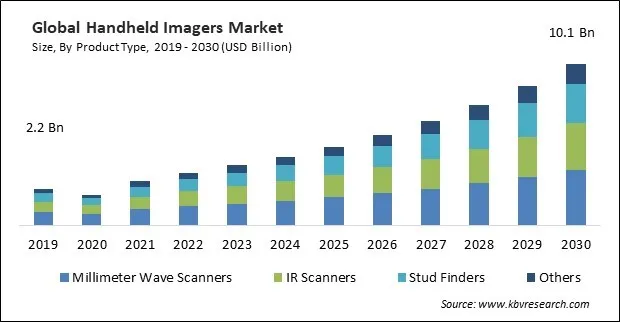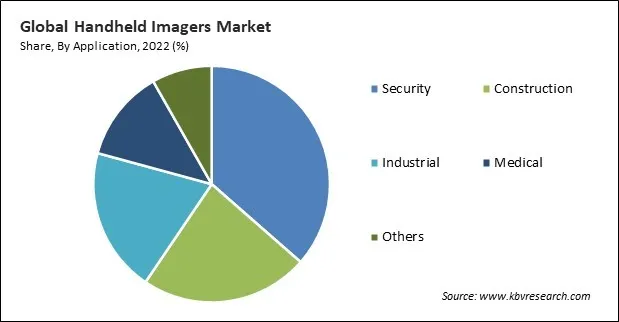The Global Handheld Imagers Market size is expected to reach $10.1 billion by 2030, rising at a market growth of 15.2% CAGR during the forecast period. In the year 2022, the market attained a volume of 9,938.9 thousand units, experiencing a growth of 15.9% (2019-2022).
Handheld imagers are also used in security training and simulation exercises. Consequently, the security segment captured $1,194.6 million revenue in the market in 2022. The portability of these imagers allows for quick deployment in response to emerging security threats. Security personnel can carry these devices on patrol, respond to incidents in real-time, and adapt to dynamic security situations, providing a flexible and effective security solution. Security personnel can practice using these devices in various scenarios, enhancing their proficiency in threat detection, surveillance, and response. Some of the factors impacting the market are Advances in imaging technologies, Surging demand across several applications and Lack of standardized protocols and interoperability.

Advances in sensor technology have led to the development of higher megapixel sensors, improving the resolution of these imagers. This results in stronger and more detailed images, critical for medical diagnostics, industrial inspections, and security surveillance applications. The integration of hyperspectral imaging allows handheld imagers to capture and analyze a wide range of wavelengths. In dermatology, they are used for skin examinations, mole mapping, and wound assessments. In ophthalmology, these devices aid in eye examinations and diagnostics. They are widely used for security screening in airports, public events, and critical infrastructure. Integration of imaging capabilities into smartphones and wearables has expanded the consumer market for them. Consumers use these devices for photography, augmented reality (AR), and virtual reality (VR) experiences. Thus, the diverse range of applications across industries demonstrates the adaptability and utility of market.
However, the absence of standardized protocols means that different imagers may use proprietary communication protocols, data formats, or interfaces. This lack of compatibility can hinder the integration of these devices with other systems and technologies, limiting their overall utility. They generate valuable data, and interoperability issues can hinder sharing of this data across platforms or between different devices. This lack of integration can result in increased costs and complexities for end-users. Proprietary standards or closed ecosystems may lead to vendor lock-in, where users become dependent on a specific manufacturer's products and services. This limits flexibility and choice for end-users, potentially hindering their ability to adapt to evolving needs or emerging technologies. Lack of interoperability often necessitates customized solutions for specific applications, leading to complex system implementations. This complexity may require additional deployment, configuration, and ongoing maintenance resources. Due to the factors mentioned above, a decline in market growth is expected.
On the basis of application, the market is segmented into security, industrial, construction, medical, and others. The industrial segment projected a prominent growth rate in the market in 2022. Industries that rely on steam systems, such as power plants or chemical processing facilities, use these imagers to monitor and inspect steam lines and components. These imagers contribute to quality control processes in manufacturing by allowing operators to inspect products for defects, irregularities, or malfunctions. The devices aid in identifying issues with product components, ensuring that manufactured goods meet stringent quality standards before reaching the market.

Based on product type, the market is fragmented into millimeter wave scanners, IR scanners, stud finders, and microbolometers. The IR scanners segment garnered a significant revenue share in the market in 2022. Widespread in the construction industry, these scanners can read, scan, and output printed codes and items to a computer signal. Using specialized electromagnetic waves, millimeter-wave scanners detect objects concealed beneath an individual's garments. These are widely implemented in airport security checkpoints and government buildings for security purposes. Microbolometers function as thermal camera detectors.
| Report Attribute | Details |
|---|---|
| Market size value in 2022 | USD 3.3 Billion |
| Market size forecast in 2030 | USD 10.1 Billion |
| Base Year | 2022 |
| Historical Period | 2019 to 2021 |
| Forecast Period | 2023 to 2030 |
| Revenue Growth Rate | CAGR of 15.2% from 2023 to 2030 |
| Number of Pages | 299 |
| Number of Tables | 570 |
| Quantitative Data | Volume in Thousand Units, Revenue in USD Billion, and CAGR from 2019 to 2030 |
| Report coverage | Market Trends, Revenue Estimation and Forecast, Segmentation Analysis, Regional and Country Breakdown, Porter’s 5 Forces Analysis, Company Profiling, Companies Strategic Developments, SWOT Analysis, Winning Imperatives |
| Segments covered | Product Type, Application, Region |
| Country scope |
|
| Companies Included | Leonardo SpA (Leonardo DRS, Inc.), BAE Systems PLC, Robert Bosch GmbH, Teledyne FLIR LLC (Teledyne Technologies Incorporated), Fortive Corporation (Fluke Corporation), General Dynamics Corporation, Danaher Corporation, Stanley Black & Decker, Inc. and Defence and Security Equipment International Ltd. |
| Growth Drivers |
|
| Restraints |
|
Region-wise, the market is analyzed across North America, Europe, Asia Pacific, and LAMEA. In 2022, the North America region witnessed the largest revenue share in the market. Due to the escalating government regulations concerning aviation security and the escalating peril of terrorism. The September 11 attacks have profoundly impacted regional demand for transportable imagers. Additionally, it is anticipated that Europe and Asia-Pacific will experience substantial development over the next six years due to rising security concerns.
Free Valuable Insights: Global Handheld Imagers Market size to reach USD 10.1 Billion by 2030
The market research report covers the analysis of key stake holders of the market. Key companies profiled in the report include Leonardo SpA (Leonardo DRS, Inc.), BAE Systems PLC, Robert Bosch GmbH, Teledyne FLIR LLC (Teledyne Technologies Incorporated), Fortive Corporation (Fluke Corporation), General Dynamics Corporation, Danaher Corporation, Stanley Black & Decker, Inc., Defence and Security Equipment International Ltd. and C.H. Hanson Company
By Product Type (Volume, Thousand Units, USD Billion, 2019-2030)
By Application (Volume, Thousand Units, USD Billion, 2019-2030)
By Geography (Volume, Thousand Units, USD Billion, 2019-2030)


This Market size is expected to reach $10.1 billion by 2030.
Advances in imaging technologies are driving the Market in coming years, however, Lack of standardized protocols and interoperability restraints the growth of the Market.
Leonardo SpA (Leonardo DRS, Inc.), BAE Systems PLC, Robert Bosch GmbH, Teledyne FLIR LLC (Teledyne Technologies Incorporated), Fortive Corporation (Fluke Corporation), General Dynamics Corporation, Danaher Corporation, Stanley Black & Decker, Inc., Defence and Security Equipment International Ltd. and C.H. Hanson Company
In the year 2022, the market attained a volume of 9,938.9 thousand units, experiencing a growth of 15.9% (2019-2022).
The Millimeter Wave Scanners segment is leading the Market, by Product Type in 2022; thereby, achieving a market value of $3.4 Billion by 2030.
The North America region dominated the Market, by region in 2022, and would continue to be a dominant market till 2030; thereby, achieving a market value of $3,281.9 Million by 2030.
Our team of dedicated experts can provide you with attractive expansion opportunities for your business.

